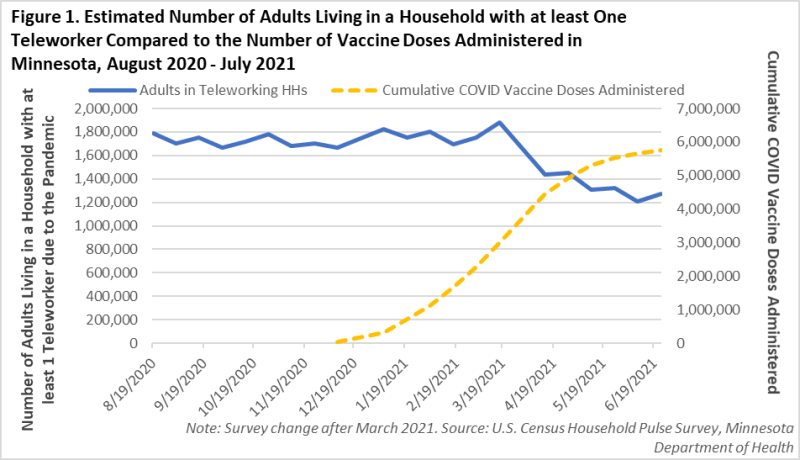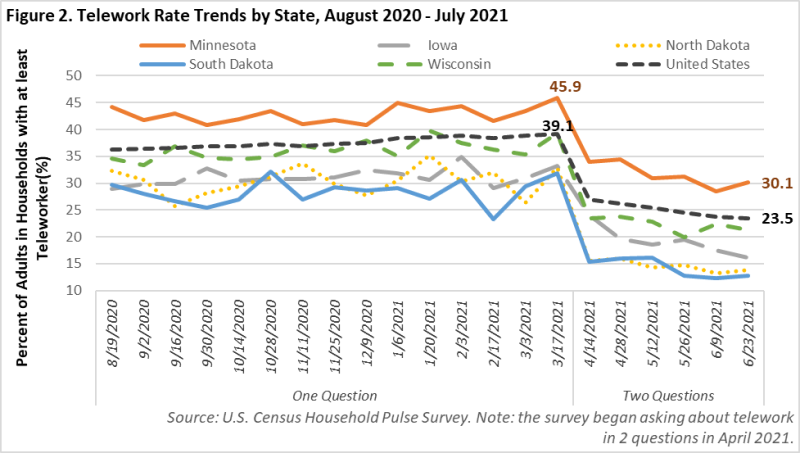by Carson Gorecki
September 2021
As the pandemic spread and many thousands of Minnesotan workers were laid off, an even larger share of workers were sent home but continued to work in some fashion. The surge of teleworking in 2020-2021 represented an acceleration of what has been a more gradual long-term increase of working from home. In 2010 only 5% (134,000) of Minnesota's workforce worked from home, which was a larger share than the national share of 4.1%1. The Minnesotan work-from-home share grew slightly to 5.9% (172,000) in 2019, yet the national work-from-home share expanded at an even faster rate to 5.2%.
The onset of COVID-19 led to some breathtaking changes in the labor market. Initially, the scale of some of these changes were unknown. A few months into the pandemic, however, the U.S. Census added a question to their newly created Household Pulse Survey, an instrument aimed at studying how the coronavirus was impacting households socially and economically in real time. Questions cover everything from difficulty covering expenses to the likelihood to get vaccinated to perceived mental health and more.
A telework question was added in the second phase of the survey which commenced in August 19, 2020. From that question, Household Pulse Survey data estimated that an average of nearly 1.8 million adult Minnesotans were living in a household with at least one worker substituting telework for in-person work for the period of August 2020 through February 2021 (see Figure 1). The number of adults impacted by telework remained somewhat constant over seven months until spring of 2021. After that point the total began to fall, roughly coinciding with the rise of vaccinations and decline of the third wave of the virus in Minnesota. As of early July, when the Household Pulse Survey stopped asking the telework question, nearly 1.3 million Minnesotans were still living in a household with at least one teleworker.

Even as the number of coronavirus cases peaked at the end of 2020 and fell significantly into the beginning of 2021, the share of workers teleworking remained relatively constant (see Figure 2). The percent of households with at least one adult teleworking fluctuated between 41% and 45% until March 2021. The teleworking rate also appears to have been largely unaffected by the drop of employment that occurred at the end of 2020. Throughout the survey period, Minnesota consistently held higher telework shares than its neighbors Iowa, Wisconsin, and the Dakotas. Each of the four neighboring states had telework shares below the national average for all but a couple weeks.

Working from home is not an option that is equally available to all workers. Educational attainment, income, occupation, and even health appears to determine whether a worker is more or less likely to be able to telework. The U.S. Census Bureau conducted analysis of their Household Pulse data earlier this year and found that households with members that teleworked more often were also more likely to have higher levels of educational attainment, higher incomes, and better health statuses.
In 2019 the BLS published a list of workers by characteristics and whether they were more or less likely to work from home. These data provide a sort of baseline before the onset of the pandemic a year later. According to the BLS, 28.8% of all workers could work from home, and 24.8% actually took advantage of that option at some point – although 1/5th of workers reported that their work at home was unpaid. While a quarter of all workers had the access and ability to work from home, that access varied significantly by level of educational attainment and income.
Workers with a bachelor's degree or higher (51.9%) were more than 10 times more likely to be able to work from home than workers with less than a high school degree (4.2%) and four times more likely than workers with only a high school degree (12.6%). In terms of income, three of every five workers with earnings in the 75th percentile or above had the option to work from home. Fewer than one of every 10 workers with earnings below the 25th percentile had that same option. The gaps in ability to work from home by education and income widen even more in terms of the share of workers that actually worked from home, indicating additional barriers for workers with lower incomes and levels of educational attainment. Those barriers may come to be highlighted in the years to follow as the option to work from home may increasingly mean the difference between employment and unemployment for many workers in Minnesota.
In addition to the Household Pulse run by the U.S. Census, the Bureau of Labor Statistics (BLS) conducts the monthly Current Population Survey (CPS). As part of its COVID-19 Supplement, the CPS asks some similar questions to the Household Pulse, but includes demographic information as well as data on occupations and industries. Unlike the Household Pulse Survey, the CPS provides an estimate of the number of individual workers teleworking. These data show that some of the teleworking disparities that existed in 2017-2018 seemed to widen under the effects of the pandemic. The occupation of a worker was particularly relevant in determining access to telework.
Since CPS data is presented at the worker level, the shares are different than the household perspective provided by the Household Pulse. In May 2020, when the CPS COVID-19 Supplement was added, 35.4% of workers nationwide were teleworking because of the pandemic. By applying the rates of teleworking by occupation to Minnesota's occupational mix, that share would translate to an estimated 860,000 workers. In January 2021 the share of workers teleworking would drop to 21.1%, and by September 2021 the share would fall to 12.2%. The estimated number of workers sat most recently at 330,000 (see Table 1).
| Occupational Group | Percent of Workers Teleworking | Estimated Number of Workers Teleworking | 2021 Median Wage | ||
|---|---|---|---|---|---|
| Jan-21 | Sep-21 | Jan-21 | Sep-21 | ||
| Computer and Mathematical | 67.6% | 43.5% | 66,410 | 42,734 | $44.89 |
| Business and Financial Operations | 53.8% | 36.9% | 96,662 | 66,298 | $35.24 |
| Legal | 57.7% | 34.2% | 11,402 | 6,758 | $41.02 |
| Life, Physical, and Social Science | 45.6% | 29.5% | 11,911 | 7,705 | $35.48 |
| Architecture and Engineering | 45.7% | 26.2% | 25,080 | 14,379 | $38.90 |
| Management | 36.6% | 23.2% | 60,218 | 38,171 | $54.22 |
| Arts, Design, Entertainment, and Media | 42.0% | 22.5% | 15,229 | 8,159 | $25.72 |
| Community and Social Service | 44.9% | 22.4% | 24,978 | 12,461 | $24.21 |
| Office and Administrative Support | 24.8% | 14.3% | 83,836 | 48,341 | $20.93 |
| Total, All Occupations | 21.1% | 12.2% | 571,972 | 330,168 | $23.00 |
| Education, Training, and Library | 44.5% | 11.6% | 70,782 | 18,451 | $24.64 |
| Sales and Related | 17.0% | 9.7% | 42,573 | 24,292 | $16.83 |
| Healthcare Practitioners and Technical | 13.1% | 9.6% | 24,656 | 18,068 | $36.90 |
| Protective Service | 8.8% | 5.1% | 3,742 | 2,169 | $24.18 |
| Personal Care and Service | 7.7% | 3.1% | 3,978 | 1,601 | $14.57 |
| Installation, Maintenance, and Repair | 3.5% | 2.7% | 3,459 | 2,669 | $25.45 |
| Healthcare Support | 4.0% | 2.5% | 6,286 | 3,929 | $15.52 |
| Construction and Extraction | 2.8% | 2.2% | 2,867 | 2,253 | $29.84 |
| Production | 3.4% | 2.1% | 6,876 | 4,247 | $19.82 |
| Building, Grounds Cleaning and Maint. | 2.8% | 1.8% | 2,087 | 1,342 | $16.14 |
| Transportation and Material Moving | 2.1% | 1.6% | 4,393 | 3,347 | $18.83 |
| Farming, Fishing, and Forestry | 1.4% | 1.5% | 59 | 63 | $18.14 |
| Food Preparation and Serving Related | 2.3% | 1.4% | 4,488 | 2,732 | $13.34 |
| Source: Bureau of Labor Statistics Current Population Survey, DEED Occupational Wage and Employment Statistics, and analyst's calculations. | |||||
The differing access workers had to telework varied greatly depending on the type of work they performed. More than two of every five workers in Computer and Mathematical occupations remained teleworking as of September 2021. More than a third of Business and Financial Operations and Legal workers also had the option to work remotely. Conversely, under 2% of Food Preparation and Serving Related, Farming, Fishing, and Forestry, Transportation and Material Moving, and Building, Grounds Cleaning, and Maintenance workers were teleworking in September. None of the bottom four occupational groups saw greater than 5% of their workforces teleworking at any point since May 2020 (see Table 1).
The occupations with the highest rates of teleworking tended also to be high-paying and less-reliant on in-person or direct interpersonal activity. The occupational groups with the lowest rates of telework were either direct service providing such as Food Preparation and Serving and/or site specific such as Construction and Extraction and Production occupations. With few exceptions the occupational groups with the lowest rates of teleworking also paid lower wages. Of the nine occupational groups with above average telework rates, only Office and Administrative Support paid wages below the state median. Among the five occupational groups with the lowest rates of teleworking were occupations with five of the eight lowest median wages.
By educational attainment level, those workers with at least a bachelor's were 3.9 times as likely to be teleworking in May of 2020 when compared to those workers with only a high school diploma. By the summer of 2021, that ratio grew to over 6 times as likely before dropping to 4.5 in September. In September, 27.2% of workers with a master's, professional, or doctoral degrees were teleworking while only 2.6% of workers with less than a high school diploma were.
From March to April 2021 there was a visible drop in the rate of teleworking in Minnesotan households. The Minnesota rate dropped nearly 16 percentage points to 30% by July. As mentioned earlier, this sudden drop could be explained – at least in part – by the mass rollout of COVID-19 vaccines to the general public and growing worker confidence. Another possible explanation, however, could be in the Household Pulse Survey itself. Between phase 3 and 3.1 the Household Pulse made what was one question about telework into two. In the process they were able to isolate better the share of households with workers who were teleworking solely because of the pandemic. The CPS data also shows a decline in teleworking during this period, but not on the same scale as seen in the Household Pulse data.
Whatever the explanation for the more recent decline in telework rates, 12% of the workforce was still teleworking because of the pandemic as of September. More than double the share of the workforce was teleworking in 2021 compared to two years previously. While we will likely see additional fluctuation in telework rates as the pandemic continues, it is much clearer now that the trend of increased telework is here to stay. Jobseekers are more often looking for positions for which telework is an option and employers are assessing traditional conceptions of the office. What is also clearer is that access to telework will remain uneven and will continue to be determined greatly by workers' education and occupation.
1data.census.gov/cedsci/table?q=s0801&g=0100000US_0400000US27&tid=ACSST5Y2019.S0801&hidePreview=true